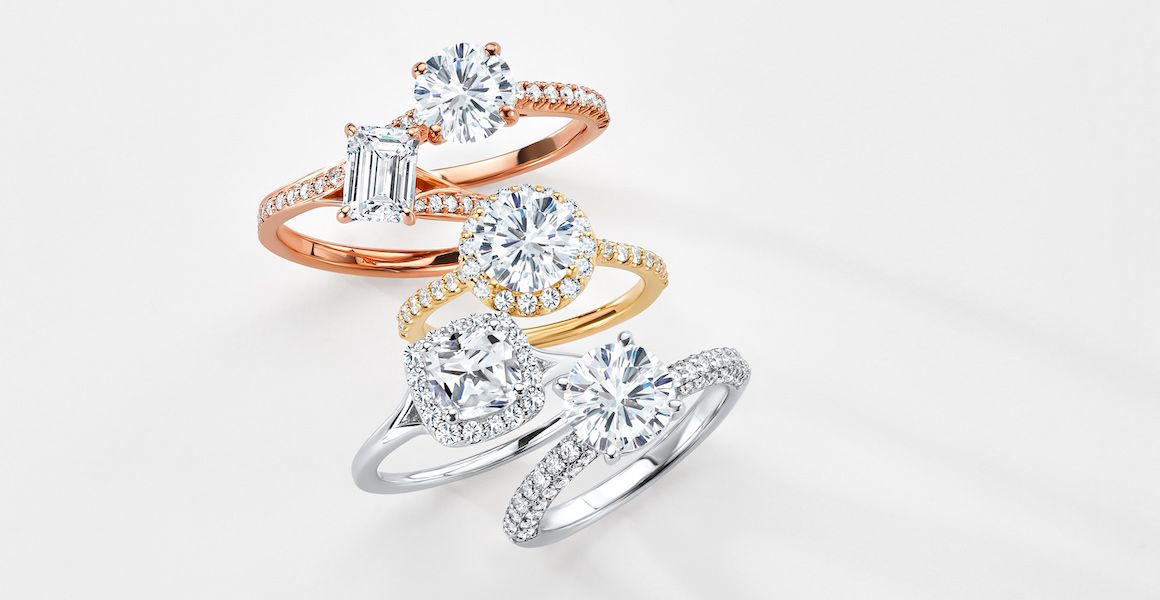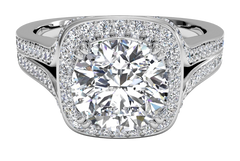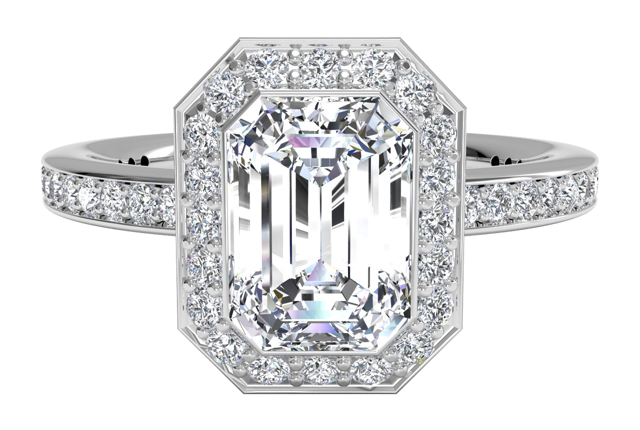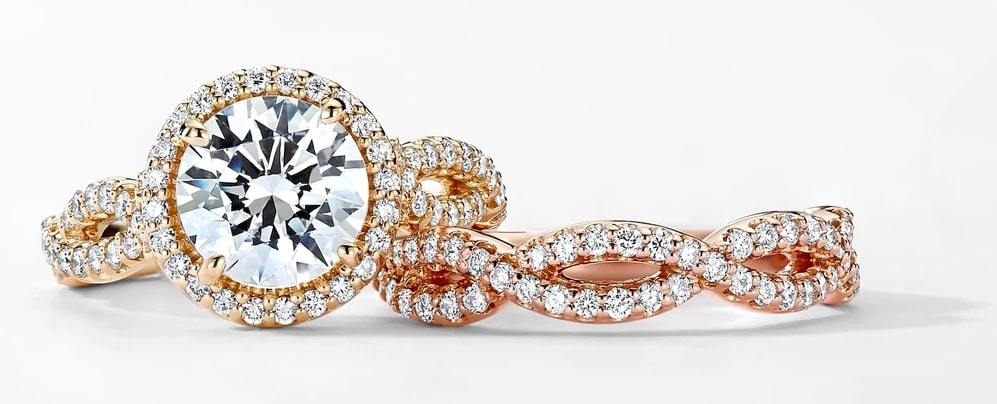Gold Engagement Rings: The Ultimate Buying Guide

Engagement rings represent one’s devotion to marry another. The round shape of the band signifies endless love for their significant other. Jewelers make engagement rings out of a myriad of materials, perhaps the most common being gold. Don’t let the lack of the classic yellow gold color fool you; gold rings come in steel-hued white gold and pinkish rose gold. Gold is a more widely used material for jewelry than you might think, so it’s not prudent to rule them out too quickly.
For all its brilliance, gold jewelry can sometimes carry a hefty price tag. This comprehensive buying guide will help make sure every penny you spend on a gold engagement ring is worth it.
Why Gold?
Gold engagement rings aren’t anything new; as early as the Victorian era (1835-1900), gold and diamonds created the ideal piece of jewelry. During this time, the rings were crafted from either yellow or rose gold. Yellow and rose gold became popular again during the Retro Era (1940-1960). During World War II, platinum wasn't allowed to be used, so jewelers used gold for engagement rings instead. Today, gold in all its varieties is still sought after for engagement rings.
Surprisingly, the metal’s softness and compatibility with other metals make it a prime choice for jewelry. Gold was soft enough to be melted into just about anything in ancient times, from coins to jewelry. Even as technology later allowed working with more rigid metals, gold had established itself as a symbol of affluence—a trait people back then strongly desired.
Gold jewelry is also long-lasting since, as a noble metal, it doesn’t corrode as easily in moist air or acid. Any gold engagement ring you give to your spouse-to-be will outlast you and countless succeeding generations and still be as lustrous as the day you got it. In a way, choosing gold can be a message of sorts—love everlasting.
Know Your Karats
As mentioned earlier, gold is very soft, so it’s usually made with alloys such as copper and zinc to increase its durability. The color of the gold depends on which alloys are added, but more on that later.
The engagement ring’s karate refers to the amount of gold in it - not to be confused with carats (the weight of a diamond).
The FTC requires gold jewelry to have an accurate disclosure of caratage. The market generally sells gold jewelry in 10K, 14K, 18K, and very rarely, 22K. Pure gold is displayed as 24K, but its softness prevents it from being worked into jewelry, let alone engagement rings.
22K Gold (91.7% Gold)
The closest to marketable gold jewelry you’ll get is 22K, which contains 91.7% gold. It provides the best possible luster, but it lacks the metal alloys to make it durable. In fact, most jewelers do not carry this karat.

If you’re in the market for the shiniest engagement ring with some resilience, 18K is your best bet. With a 75% gold and 25% alloy ratio, 18K gold rings are practical enough to don a ring finger. As gold isn’t known to cause allergic reactions, the gold majority means it’ll be less likely to trigger them amidst the alloy content.
Nevertheless, 18K still doesn’t have enough alloys to protect it from scratches and other forms of damage.
18K Gold (75% Gold)
14K Gold (58.3% Gold)
For a three-way balance of luster, resilience, and value for money, you can’t go wrong with 14K. It’s the most popular caratage in Western countries, with nine out of ten gold engagement rings being of this purity.
While less intense than 18K gold, it still has enough gold hue to make it brilliant. It’s slightly less expensive than 18K gold since it has less gold content.
10K Gold (41.7% Gold)
If you’re still concerned about the cost, 10K is as low as you’ll most likely get. This caratage contains more alloys than gold itself (58.3% alloys vs. 41.7% gold). With that much alloy inside, physical damage won’t be much of an issue.
However, there are a few reasons most jewelry stores don’t carry 10K gold jewelry. Its low gold content means it can be hard to convince customers that it’s real gold. Also, the risk of allergy is higher because of the alloys. At this point, much of the gold’s iconic luster is gone.
More importantly, be wary of sources trying to sell you 25K and 26K gold engagement rings. Keep in mind that 24K gold is as pure as it gets, at 99.9% gold—and, as explained before, it’s not an ideal caratage for jewelry.
Beyond Yellow Gold
Most people get gold engagement rings for the brilliant color, but yellow gold isn’t the only hue out there. Jewelry stores also sell other variants, mainly white gold and rose gold. They’re made possible by the addition of specific metals. The correct variant is all a matter of preference.

At Ritani, white gold is far more popular than yellow gold. Many buyers go for white gold rings as a more affordable alternative to platinum for their likeness. You can put these two rings side by side and still can’t tell the difference. White gold tweaks the type and amount of alloys to yield a platinum-like appearance. It typically contains palladium, zinc, silver, and nickel.
Currently, 22K white gold doesn’t exist in the market. The 8.3% alloy allocation needed to make it 22k white gold isn’t enough to create a silvery appearance.
Compared to platinum rings, white gold rings cost between 40% and 50% less. Ritani’s most expensive 18K white gold setting costs close to $8,000, while the same setting in platinum is almost $9,000.

Rose gold engagement rings get their color from the higher copper content. Unlike white gold, rose gold can get its tinge even at 22K (though still too soft because of the high gold content). Below are some examples:
White Gold
Rose Gold
- 10K Rose Gold – 20% silver, 42.5% copper
- 14K Rose Gold – 9.2% silver, 32.5% copper
- 18K Rose Gold – 9.2% silver, 22.2% copper
- 22K Rose Gold – only 8.4% copper
Rose gold shouldn’t be mistaken for pink gold or red gold. These two have different gold-alloy ratios.
One astounding thing about rose gold rings is that they’re more durable than yellow and white gold rings. The extra copper gives rose gold rings more strength. However, the abundance of alloys also means it’s more likely to trigger allergies.
Learn how to save money & choose the right diamond for your yellow gold or rose gold engagement ring here.
Final Thoughts
When shopping for a gold engagement ring, you’ll most likely encounter 14K and 18K yellow gold and white gold options. Here’s a breakdown of how to choose among them.
- The higher the caratage, the more susceptible it is to damage
- The lower the caratage, the less apparent its gold luster
- The 14K ring offers a great balance of cost, durability, and sheen
- When considering platinum rings, take a look at white gold rings first
- Go for more gold (and caratage) if the wearer has a known metal-based allergy
Other than these quick tips, choosing an engagement ring all boils down to your preference. It’s important that you take your time in choosing the right ring; it’s going to your significant other’s ring finger, after all. If you need any help in your purchasing decision, feel free to contact us, and we will help you get the best gold engagement ring that fits all your needs at a great price.

